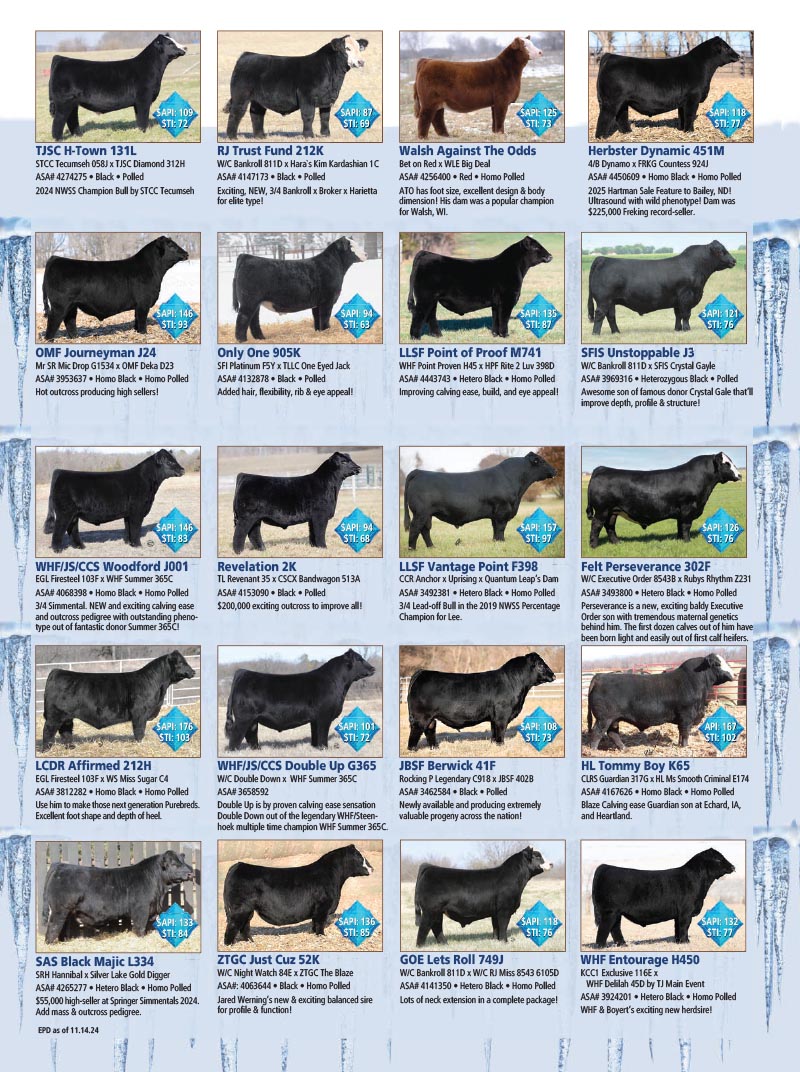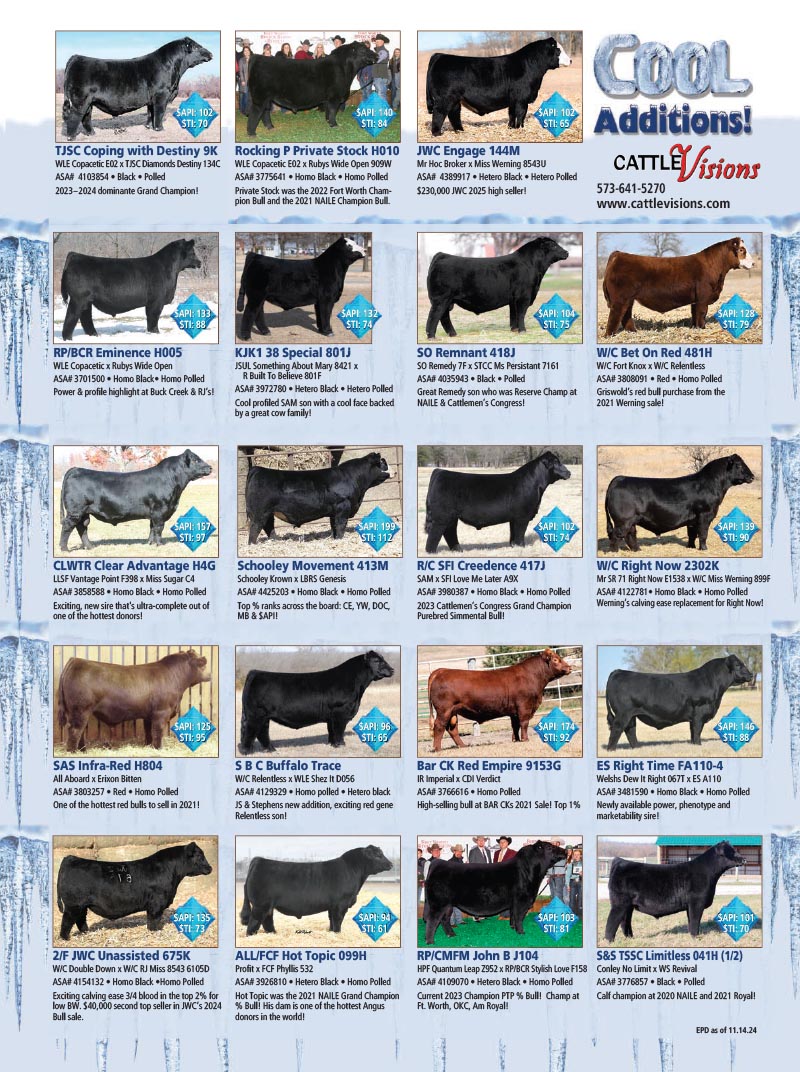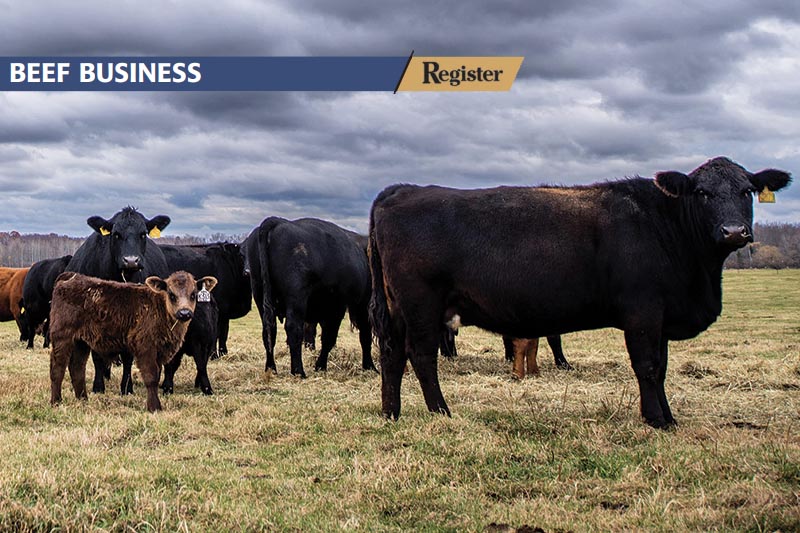Bulls and Breeding Soundness Examinations
Mark Z. Johnson, Oklahoma State University Extension
A significant portion of reproductive failures in cow-calf enterprises are due to the fertility of the herd bull. With turnout just around the corner, it’s time to focus on your bull battery.
Most spring-calving cow-calf operations are approaching the start of the breeding season. There are some important management considerations to keep in mind during this pre-turnout period: 1) have a veterinarian conduct a breeding soundness exam (BSE) on all potential herdsires, 2) monitor body condition score of your bulls on inventory to make sure they are in Body Condition Score of 6 by turnout, and 3) slowly transition the newly purchased young bulls to a forage-based diet.
Bull breeding soundness is one of the most economically important traits for cow-calf producers. Accordingly, a BSE is recommended to measure a bull’s potential to achieve satisfactory conception rates. The BSE should include examination of the reproductive anatomy, scrotal measurement, sperm motility, sperm morphology (physical characteristics), locomotion, eyesight, and body condition score. A bull that passes the BSE appears to be sound for breeding purposes as best as science can determine at that point in time. Bulls should have a BSE six to eight weeks prior to turnout. If a bull fails the BSE, this allows producers to have enough time to replace the animal with a sound bull for the breeding season.
Each year cow-calf operations purchase yearling bulls to replace sub-fertile bulls or poor genetics. If new bulls have been developed on a grain-based, high-energy diet, they have the potential to be overconditioned. New bulls should be gradually transitioned to a lower-energy, forage-based grazing system over the 30–60 days before being turned out on cows. This period can allow the bull to shed excess fat and reach an optimum body condition for the breeding season. These bulls should be kept in a large enough pen or pasture so they can get daily exercise. When multiple bulls are used in a single pasture, they should be exposed to each other prior to turnout to minimize bull interactions once they join the cow herd. Bottom line: it’s time to plan for your next breeding season.
Five Must-Do Steps for Raising Healthy Beef-on-Dairy Calves before They Leave the Farm
by Taylor Leach, Bovine Veterinarian
With beef-on-dairy calves in high demand and day-old prices sky high, ensuring these crossbred calves get off to the best possible start has become a must for dairy producers. Not only does proper care improve calf health, but it also maximizes their market value and long-term performance. During the I-29 Moo University Dairy Beef Short Course, Dr. Gail Carpenter, Iowa State University Assistant Professor of Outreach and Extension, explained that the first few days are make-or-break for setting these calves up for success.
Here are her top five priorities dairy producers should focus on:
1. Breed the right calves in the first place
Before a beef-on-dairy calf is even born, Carpenter notes that the right breeding decisions make all the difference. Choosing the best cows and bulls helps ensure easy calvings, healthy calves, and animals that bring top dollar down the road. For her, this means creating calves that hit the ground strong, grow well, and meet market demands — whether through feedlot performance or carcass quality. Therefore, a little planning up front goes a long way in setting up both your dairy and beef programs for success.
“Beef-on-dairy is an inventory management practice first and foremost,” Carpenter says. “It’s easy to be pulled toward making a lot of beef-on-dairy calves. But don’t forget, you also have to keep milking cows, so make sure that you’re protecting your replacement numbers as well.”
Beyond determining the ideal number of beef-on-dairy calves, she emphasizes the importance of selecting the right dams and bulls. “Whether it’s using [tools like] genomics, health data, or parent averages, it’s essential to breed the right number of calves and select the right cows for beef semen,” she adds. “Make sure you’re choosing for traits like calving ease and conception rate. I think we’re going to see a bigger drive toward breeding for more carcass traits and producing a high-quality product.”
2. Prioritize maternity management
Next on Carpenter’s list is a clean and well-managed maternity area. “Keeping calving pens clean, ensuring cows have access to clean water, and avoiding overstocking are fundamental practices,” Carpenter notes. “Whatever your maternity system is — whether it’s just-in-time calving or a designated maternity pen — manage it well and keep a close eye on those cows.”
Beyond cleanliness, attention to detail in maternity care makes a difference. “Make sure you’re cleaning your tools, using them productively, and maintaining calf housing and bedding properly,” Carpenter adds. “Bottles, nipples, and all feeding equipment should be kept clean to ensure the best start for your calves.”
Producers should be mindful of monitoring cows closely for signs of labor and assisting when necessary. Using clean equipment for calving assistance, ensuring newborns receive immediate care, and minimizing stress in the maternity area all contribute to better outcomes. Carpenter notes that a well-managed maternity area helps reduce disease risk and ensures calves are born into a safe, healthy environment.
3. Ensure proper colostrum management
Colostrum is the foundation of a calf’s immune system and is crucial for setting the stage for good health. Without enough high-quality colostrum, a calf’s ability to fight infections and thrive early in life is compromised. “Colostrum is going to be critical whether it’s for your replacements or your beef-on-dairy calves. Use the same high-quality colostrum across the board,” Carpenter says. “If volume is an issue, colostrum replacers can be a valuable tool to make sure calves get the antibodies they need.”
Providing colostrum quickly after birth is essential, as the calf’s gut is most open to absorbing antibodies within the first few hours. The sooner you can get it into them, the better their chances are for developing a strong immunity and preventing future health issues.
Key colostrum practices include:
• Ensuring calves receive high-quality colostrum within the first few hours of life. This is crucial for the calf to get the right amount of antibodies.
• Using a Brix refractometer to confirm colostrum quality (ideally 22% or higher). This helps you ensure the colostrum is rich in immunoglobulins, which are vital for the calf’s immune system.
• Feeding colostrum at the correct temperature to maximize absorption. Warm colostrum (around 100°F) ensures that calves can properly absorb all the beneficial nutrients.
4. Implement a solid pre-transport health plan
Before a calf leaves the farm, it’s crucial to ensure it receives all the necessary health interventions to set it up for success in its next stage of life. Having a solid pre-transport health plan in place not only supports the calf’s health but can also help meet buyer requirements and avoid any issues during transport. “Vaccination protocols vary, so it’s essential to work with your vet and buyers to develop a plan that suits your operation,” Carpenter notes.
Beyond vaccinations, several other practices can help ensure calves stay healthy during their move. Common pre-transport practices include the following:
• Administering vaccinations based on the farm’s disease risks. Vaccinations should be tailored to protect calves from the most common diseases in your area or based on specific risks your operation faces.
• Navel dipping to prevent infections. Newborn calves are especially susceptible to infection, so dipping the navel in an antiseptic solution helps prevent bacterial infections from entering through the umbilical cord.
• Ensuring calves are well-fed and hydrated before transport. Well-nourished, hydrated calves are less stressed and more resilient during transport. Make sure they’ve had a good meal and are drinking before leaving the farm.
5. Maintain a clean, comfortable environment
Creating a comfortable environment for your beef-on-dairy calves is one of the simplest yet most impactful ways to ensure their health and long-term performance. A calf’s first few days are crucial, and the conditions they are raised in directly affect their growth, immunity, and overall well-being. “Keeping the calf’s environment clean and well-ventilated, ensuring calves stay warm and dry, and minimizing stress are all things within a producer’s control,” explains Carpenter.
To truly optimize calf comfort, producers should focus on several areas:
• Provide deep, dry bedding to help regulate body temperature. Bedding plays a big role in keeping calves warm and comfortable. Fresh, dry bedding such as straw or shavings can help calves maintain their body temperature. Change bedding regularly to ensure it stays clean and dry, as damp bedding can lead to problems like pneumonia or scours.
• Maintain proper airflow to reduce respiratory disease risk. Good ventilation is essential for calf health. Poor air circulation can lead to respiratory issues, which are common in calves and can impact their long-term health. Make sure the housing area is well-ventilated but free from drafts, which could cause chilling.
Setting Calves Up for Success
Managing beef-on-dairy calves isn’t just about checking off a few boxes — it’s about paying attention to the little things every step of the way. By focusing on these five key priorities, farmers can give their calves the best start possible, making sure they stay healthy and strong for their next chapter of life. .



